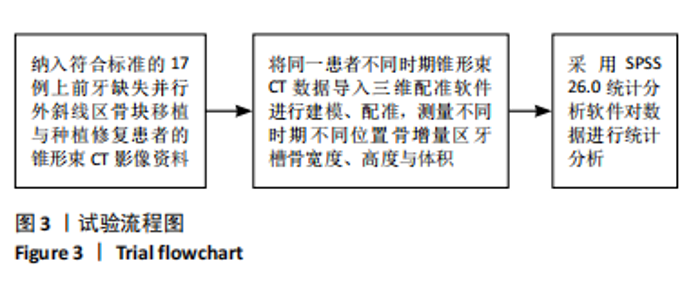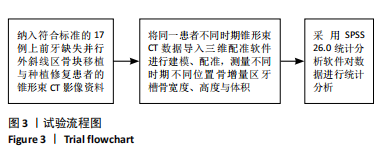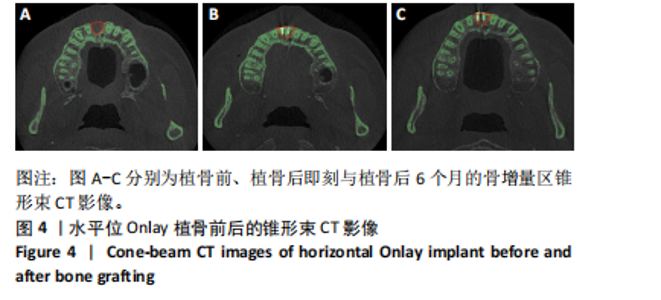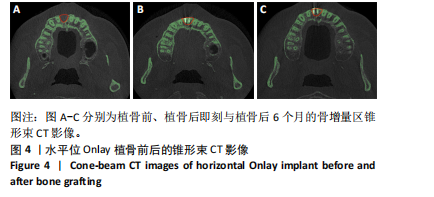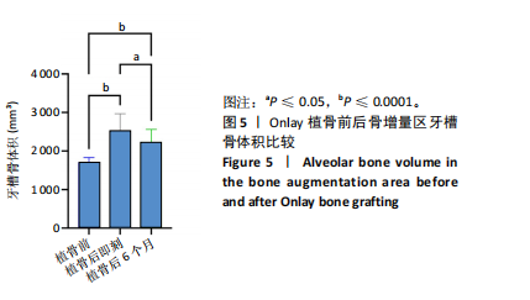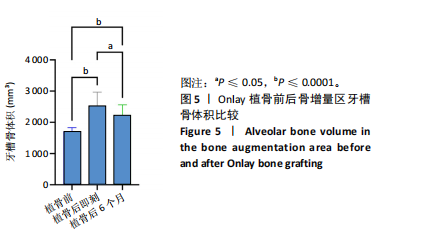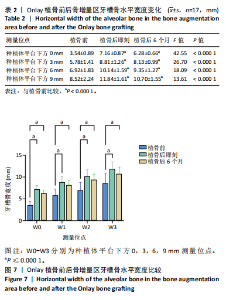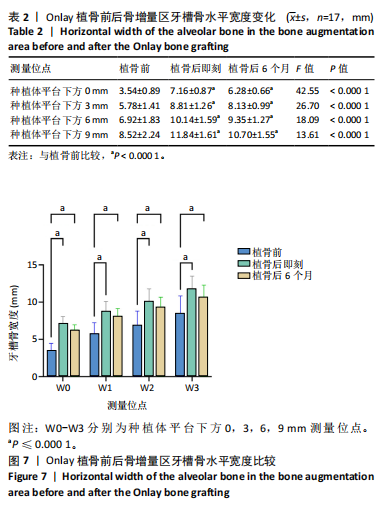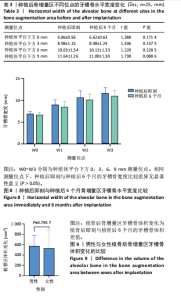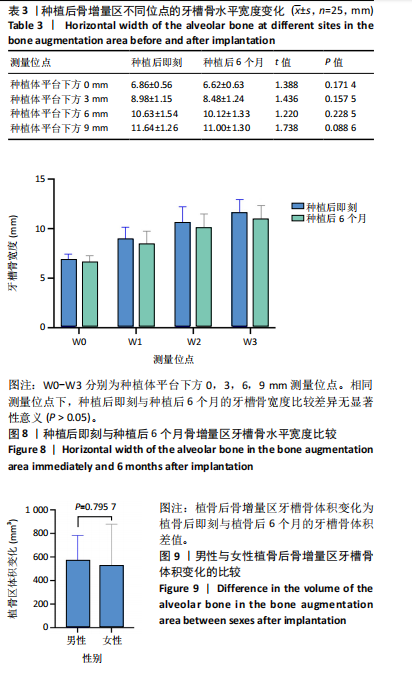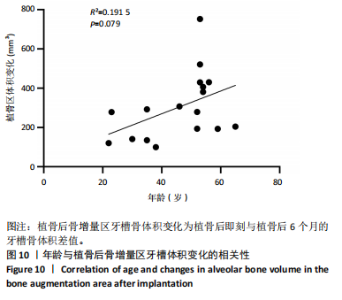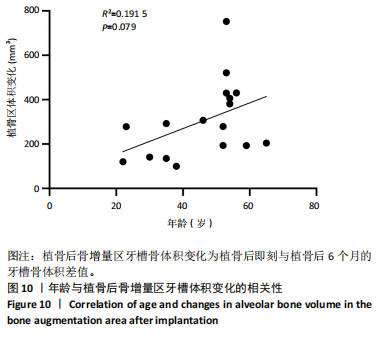Chinese Journal of Tissue Engineering Research ›› 2026, Vol. 30 ›› Issue (4): 841-848.doi: 10.12307/2025.959
Previous Articles Next Articles
Application of Onlay bone grafts from mandibular lateral oblique line in implant restoration of bone defects in upper anterior teeth
Xu Shencong1, Fang Zifei2, Ji Mingyi1, Xu Chengrui1, Li Binhong3, Cao Jiayu1, Xu Junfeng1, 2
- 1School of Stomatology, Zhejiang Chinese Medical University, Hanzhou 310053, Zhejiang Province, China; 2Department of Stomatology, Zhejiang Tongde Hospital, Hangzhou 310012, Zhejiang Province, China; 3Department of Stomatology, The First People’s Hospital of Linping District, Hangzhou 310000, Zhejiang Province, China
-
Received:2024-10-24Accepted:2024-12-18Online:2026-02-08Published:2025-05-16 -
Contact:Xu Junfeng, Chief physician, School of Stomatology, Zhejiang Chinese Medical University, Hanzhou 310053, Zhejiang Province, China; Department of Stomatology, Zhejiang Tongde Hospital, Hangzhou 310012, Zhejiang Province, China -
About author:Xu Shencong, Master candidate, Physician, School of Stomatology, Zhejiang Chinese Medical University, Hanzhou 310053, Zhejiang Province, China
CLC Number:
Cite this article
Xu Shencong, Fang Zifei, Ji Mingyi, Xu Chengrui, Li Binhong, Cao Jiayu, Xu Junfeng. Application of Onlay bone grafts from mandibular lateral oblique line in implant restoration of bone defects in upper anterior teeth[J]. Chinese Journal of Tissue Engineering Research, 2026, 30(4): 841-848.
share this article
Add to citation manager EndNote|Reference Manager|ProCite|BibTeX|RefWorks
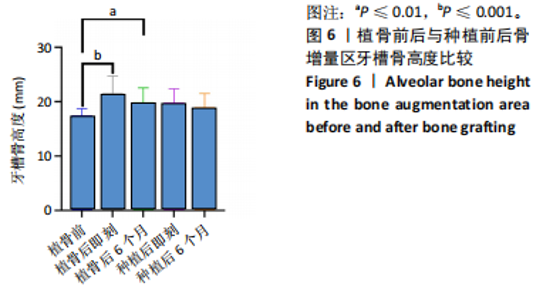
2.4 Onlay植骨前后及种植前后骨增量区牙槽骨高度检测结果 植骨前骨增量区牙槽骨高度为(17.46±1.20) mm,植骨后即刻骨增量区牙槽骨高度为(21.53±3.08) mm,植骨后6个月骨增量区牙槽骨高度为(19.89±2.55) mm,种植后即刻骨增量区牙槽骨高度为(19.81±2.48) mm,种植后6个月骨增量区牙槽骨高度为(18.93±2.47) mm,5个时间点间的骨增量区牙槽骨高度比较差异有显著性意义(F=4.851,P=0.001 7)。 植骨后即刻、植骨后6个月的骨增量区牙槽骨高度大于植骨前(P≤0.001,P≤0.01),其余时间点间骨增量区牙槽骨高度比较差异均无显著性意义(P > 0.05),见图6。表明Onlay植骨手术可获得较为明显的垂直向骨增量。 2.5 Onlay植骨前后骨增量区牙槽骨水平宽度检测结果 相同测量位点下,植骨前、植骨后即刻与植骨后6个月间牙槽骨水平宽度总体比较差异均有显著性意义"
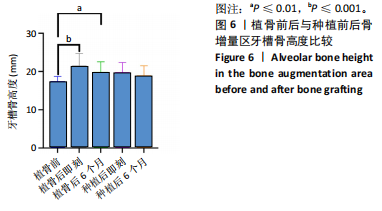
| [1] BUSER D, BELSER U, WISMEIJER D. Implant therapy in the esthetic zone. Single tooth replacements. The ITI treatment guide volume 1. Berlin: Quintessence Publ, 2007. [2] WANG J, LUO Y, QU Y, et al. Horizontal ridge augmentation in the anterior maxilla with in situ onlay bone grafting: A retrospective cohort study. Clin Oral Investig. 2022;26(9):5893-5908. [3] SMEETS R, MATTHIES L, WINDISCH P, et al. Horizontal augmentation techniques in the mandible: a systematic review. Int J Implant Dent. 2022;8(1):23. [4] BAZSEFIDPAY N, HOLMQVIST F, KHALIL D, et al. Antibiotic prescription in bone augmentation and dental implant procedures: a multi-center study. BMC Oral Health. 2023;23(1):818. [5] ATEF M, OSMAN AH, HAKAM M. Autogenous interpositional block graft vs onlay graft for horizontal ridge augmentation in the mandible. Clin Implant Dent Relat Res. 2019;21(4):678-685. [6] GAMBORENA I, SASAKI Y, BLATZ MB. Predictable immediate implant placement and restoration in the esthetic zone. J Esthet Restor Dent. 2021;33(1):158-172. [7] CHAPPUIS V, RAHMAN L, BUSER R, et al. Effectiveness of Contour Augmentation with Guided Bone Regeneration: 10-Year Results. J Dent Res. 2018;97(3):266-274. [8] ALOY-PRÓSPER A, CARRAMOLINO-CUÉLLAR E, PEÑARROCHA-OLTRA D, et al. Intraoral onlay block bone grafts versus cortical tenting technique on alveolar ridge augmentations: a systematic review. Med Oral Patol Oral Cir Bucal. 2022;27(2):e181-e190. [9] KUCHLER U, VON ARX T. Horizontal ridge augmentation in conjunction with or prior to implant placement in the anterior maxilla: a systematic review. Int J Oral Maxillofac Implants. 2014;29 Suppl:14-24. [10] 李晋蒙,李笑班,张健.复杂牙槽骨缺损临床解决方案的探索与思考[J].中国口腔种植学杂志,2022,27(5):285-291. [11] CAWOOD JI, HOWELL RA. A classification of the edentulous jaws. Int J Oral Maxillofac Surg. 1988;17(4):232-236. [12] RAMANAUSKAITE A, SADER R. Esthetic complications in implant dentistry. Periodontol 2000. 2022;88(1):73-85. [13] MORTON D, WISMEIJER D, CHEN S, et al. Group 5 ITI Consensus Report: Implant placement and loading protocols. Clin Oral Implants Res. 2023; 34 Suppl 26:349-356. [14] MA G, WU C, SHAO M. Simultaneous implant placement with autogenous onlay bone grafts: a systematic review and meta-analysis. Int J Implant Dent. 2021;7(1):61. [15] SCHMIDT AH. Autologous bone graft: Is it still the gold standard?. Injury. 2021;52 Suppl 2:S18-S22. [16] FERRAZ MP. Bone grafts in dental medicine: An overview of autografts, allografts and synthetic materials. Materials (Basel). 2023;16(11):4117. [17] STRICKER A, JACOBS R, MAES F, et al. Resorption of retromolar bone grafts after alveolar ridge augmentation-volumetric changes after 12 months assessed by CBCT analysis. Int J Implant Dent. 2021;7(1):7. [18] 史远,杨国利.外斜线取骨自体骨移植及其他牙槽嵴骨增量法的研究进展[J].口腔医学,2021,41(6):557-560,571. [19] 周铭浩,段妍,侯立鹏,等.上颌前牙单牙缺失的种植修复:分阶段实现种植美学[J].实用口腔医学杂志,2022,38(6):819-824. [20] EL-SIOUFI I, OIKONOMOU I, KOLETSI D, et al. Clinical evaluation of different alveolar ridge preservation techniques after tooth extraction: A randomized clinical trial. Clin Oral Investig. 2023;27(8):4471-4480. [21] ATIEH MA, ALSABEEHA NH, PAYNE AG, et al. Interventions for replacing missing teeth: alveolar ridge preservation techniques for dental implant site development. Cochrane Database Syst Rev. 2021;4(4):CD010176. [22] 夏婷婷,汪涌.重度牙周炎后牙位点保存术中联合应用浓缩生长因子的疗效评价[J].上海口腔医学,2023,32(6):650-655. [23] 苏雅娣,邹节娟,王超,等.3D打印个性化钛网辅助下的引导骨再生与块状自体骨移植在复杂牙槽骨缺损重建中的临床回顾性研究[J].中国口腔种植学杂志,2024,29(2):169-177. [24] MAZURAT R, CHEN S, BUSER D. Implant Placement in Post‐Extraction Sites: ITI Treatment Guide, Volume 3. J Dent Educ. 2009;73.doi:10.1002/j.0022-0337.2009.73.9.tb04804.x. [25] URBAN I, MONTERO E, SANZ-SÁNCHEZ I, et al. Minimal invasiveness in vertical ridge augmentation. Periodontol 2000. 2023;91(1):126-144. [26] ALOTAIBI FF, ROCCHIETTA I, BUTI J, et al. Comparative evidence of different surgical techniques for the management of vertical alveolar ridge defects in terms of complications and efficacy: A systematic review and network meta-analysis. J Clin Periodontol. 2023;50(11):1487-1519. [27] 王熙,王芳,刘莎.骨片移植技术与引导性骨再生技术的牙槽嵴水平骨增量效果及患者疼痛度比较[J].口腔颌面修复学杂志, 2023,24(5):354-360. [28] 郭倩文,刘明丽,韩文利,等.“香肠技术”在下颌后牙区水平向骨增量中的临床疗效分析[J].口腔医学研究,2021,37(12): 1130-1134. [29] 陈江,丘雨蓓.数字化技术在口腔种植骨增量中的应用及研究进展[J].中国口腔种植学杂志,2024,29(3):252-257. [30] URBAN IA, NAGURSKY H, LOZADA JL, et al. Horizontal ridge augmentation with a collagen membrane and a combination of particulated autogenous bone and anorganic bovine bone-derived mineral: a prospective case series in 25 patients. Int J Periodontics Restorative Dent. 2013;33(3):299-307. [31] ELNAYEF B, PORTA C, SUÁREZ-LÓPEZ DEL AMO F, et al. The Fate of Lateral Ridge Augmentation: A Systematic Review and Meta-Analysis. Int J Oral Maxillofac Implants. 2018;33(3):622-635. [32] LUO Q, LUO Y, LIU J, et al. The influence of bone block graft position on bone dimensional changes in staged onlay horizontal ridge augmentation: A 6-month retrospective cohort study. Clin Oral Implants Res. 2024;35(9):1091-1100. [33] 龚伶玲,冯波.同术区Onlay植骨在前牙牙槽嵴严重水平缺损种植修复中的临床应用效果评价[J].临床口腔医学杂志,2022,38(8): 492-496. [34] SU Y, TANG J, MIN S, et al. Alveolar ridge dimensional changes following ridge preservation procedure with novel devices: part 3 - histological analysis in non-human primate model. Clin Oral Implants Res. 2017; 28(11):e252-e261. [35] OMRAN M, MIN S, ABDELHAMID A, et al. Alveolar ridge dimensional changes following ridge preservation procedure: Part‐2 – CBCT 3D analysis in non‐human primate model. Clin Oral Implants Res. 2016;27(7):859-866. [36] POHL S, BULJAN M. Bone Shell Technique with Relocated Crestal Ridge Segment for Anterior Horizontal Mandibular Ridge Atrophy: A Case Series. Int J Periodontics Restorative Dent. 2023;43(5):596-605. [37] PANG KM, SHIN Y, PARK JY, et al. Long-Term Outcomes of Implants Placed in Autogenous Onlay Bone Grafts Harvested from Mandibular Ramus and Risk Analysis. Int J Oral Maxillofac Implants. 2021;36(4): 745-754. [38] DAOUD S, ZOABI A, KASEM A, et al. Computer-Assisted Evaluation Confirms Spontaneous Healing of Donor Site One Year following Bone Block Harvesting from Mandibular Retromolar Region-A Cohort Study. Diagnostics (Basel). 2024;14(5):504. [39] FLORES HERNÁNDEZ JG, MAGAÑA FG, HIDALGO HOM, et al. Changes in Volume and Bone Density of Calvarial Grafts After Two Years of Orbital Reconstruction. J Craniofac Surg. 2024;35(2):682-685. [40] MORASCHINI V, LOURO RS, SON A, et al. Long-term survival and success rate of dental implants placed in reconstructed areas with extraoral autogenous bone grafts: A systematic review and meta-analysis. Clin Implant Dent Relat Res. 2024;26(3):469-481. [41] KIM NH, YANG BE, ON SW, et al. Customized three-dimensional printed ceramic bone grafts for osseous defects: a prospective randomized study. Sci Rep. 2024;14(1):3397. [42] LANGALIYA A, GAIKWAD PU, SINGH TK, et al. Bone augmentation in dental implants among Indian patients. Bioinformation. 2023;19(13): 1307-1311. [43] CHIAPASCO M, TOMMASATO G, PALOMBO D, et al. A retrospective 10‐year mean follow‐up of implants placed in ridges grafted using autogenous mandibular blocks covered with bovine bone mineral and collagen membrane. Clin Oral Implants Res. 2020;31(4):328-340. [44] XIE Y, LI S, ZHANG T, et al. Titanium mesh for bone augmentation in oral implantology: Current application and progress. Int J Oral Sci. 2020;12(1):37. [45] LI L, WANG C, LI X, et al. Research on the dimensional accuracy of customized bone augmentation combined with 3D-printing individualized titanium mesh: A retrospective case series study. Clin Implant Dent Relat Res. 2021;23(1):5-18. [46] 王凌旭,王芳芳,王鹏来.个性化增材制造钛网在口腔种植骨增量中的应用及研究进展[J].中国口腔种植学杂志,2023,28(5):364-370. [47] LI S, ZHAO J, XIE Y, et al. Hard tissue stability after guided bone regeneration: a comparison between digital titanium mesh and resorbable membrane. Int J Oral Sci. 2021;13(1):37. [48] CIOCCA L, LIZIO G, BALDISSARA P, et al. Prosthetically CAD-CAM–guided bone augmentation of atrophic jaws using customized titanium mesh: Preliminary results of an open prospective study. J Oral Implantol. 2018;44(2):131-137. |
| [1] | Pan Hongfei, Zhuang Zhenbing, Xu Baiyun, Yang Zhangyang, Lin Kairui, Zhan Bingqing, Lan Jinghan, Gao Heng, Zhang Nanbo, Lin Jiayu. Inhibitory effects of different concentrations of auranofin on M1 macrophage function and its therapeutic potential in diabetic wound healing [J]. Chinese Journal of Tissue Engineering Research, 2026, 30(6): 1390-1397. |
| [2] | Peng Zhiwei, Chen Lei, Tong Lei. Luteolin promotes wound healing in diabetic mice: roles and mechanisms [J]. Chinese Journal of Tissue Engineering Research, 2026, 30(6): 1398-1406. |
| [3] | Yang Zhijie, Zhao Rui, Yang Haolin, Li Xiaoyun, Li Yangbo, Huang Jiachun, Lin Yanping, Wan Lei, HuangHongxing. Postmenopausal osteoporosis: predictive values of muscle mass, grip strength, and appendicular skeletal muscle index [J]. Chinese Journal of Tissue Engineering Research, 2026, 30(5): 1073-1080. |
| [4] | Yin Yongcheng, Zhao Xiangrui, Yang Zhijie, Li Zheng, Li Fang, Ning Bin. Effect and mechanism of peroxiredoxin 1 in microglial inflammation after spinal cord injury [J]. Chinese Journal of Tissue Engineering Research, 2026, 30(5): 1106-1113. |
| [5] | Zhang Jiuxuan, Zhang Jinnan, Sui Xiaofan, Pei Xiaxia, Wei Jianhong, Su Qiang, Li Tian. Effects of ammonia poisoning on cognitive behavior and hippocampal synaptic damage in mice [J]. Chinese Journal of Tissue Engineering Research, 2026, 30(5): 1122-1128. |
| [6] | Sun Yajie, Zhao Xinchen, Bo Shuangling. Spatiotemporal expression of bone morphologic protein 7 in mouse kidney development [J]. Chinese Journal of Tissue Engineering Research, 2026, 30(5): 1156-1161. |
| [7] | Li Haojing, Wang Xin, Song Chenglin, Zhang Shengnan, Chen Yunxin. Therapeutic efficacy of extracorporeal shock wave therapy in the upper trapezius muscle area combined with exercise control training in patients with chronic non-specific neck pain [J]. Chinese Journal of Tissue Engineering Research, 2026, 30(5): 1162-1170. |
| [8] | Liu Yu, Lei Senlin, Zhou Jintao, Liu Hui, Li Xianhui. Mechanisms by which aerobic and resistance exercises improve obesity-related cognitive impairment [J]. Chinese Journal of Tissue Engineering Research, 2026, 30(5): 1171-1183. |
| [9] | Yu Huifen, Mo Licun, Cheng Leping. The position and role of 5-hydroxytryptamine in the repair of tissue injury [J]. Chinese Journal of Tissue Engineering Research, 2026, 30(5): 1196-1206. |
| [10] | Wang Zhengye, Liu Wanlin, Zhao Zhenqun. Advance in the mechanisms underlying miRNAs in steroid-induced osteonecrosis of the femoral head [J]. Chinese Journal of Tissue Engineering Research, 2026, 30(5): 1207-1214. |
| [11] | Bu Yangyang, Ning Xinli, Zhao Chen. Intra-articular injections for the treatment of osteoarthritis of the temporomandibular joint: different drugs with multiple combined treatment options [J]. Chinese Journal of Tissue Engineering Research, 2026, 30(5): 1215-1224. |
| [12] | Wen Fan, Xiang Yang, Zhu Huan, Tuo Yanfang, Li Feng. Exercise improves microvascular function in patients with type 2 diabetes [J]. Chinese Journal of Tissue Engineering Research, 2026, 30(5): 1225-1235. |
| [13] | Liu Xinyue, Li Chunnian, Li Yizhuo, Xu Shifang. Regeneration and repair of oral alveolar bone defects [J]. Chinese Journal of Tissue Engineering Research, 2026, 30(5): 1247-1259. |
| [14] | Leng Xiaoxuan, Zhao Yuxin, Liu Xihua. Effects of different neuromodulatory stimulation modalities on non-motor symptoms in Parkinson’s patients: a network meta-analysis [J]. Chinese Journal of Tissue Engineering Research, 2026, 30(5): 1282-1293. |
| [15] | Wen Xiaolong, Weng Xiquan, Feng Yao, Cao Wenyan, Liu Yuqian, Wang Haitao. Effects of inflammation on serum hepcidin and iron metabolism related parameters in patients with type 2 diabetes mellitus: a meta-analysis [J]. Chinese Journal of Tissue Engineering Research, 2026, 30(5): 1294-1301. |
| Viewed | ||||||
|
Full text |
|
|||||
|
Abstract |
|
|||||
